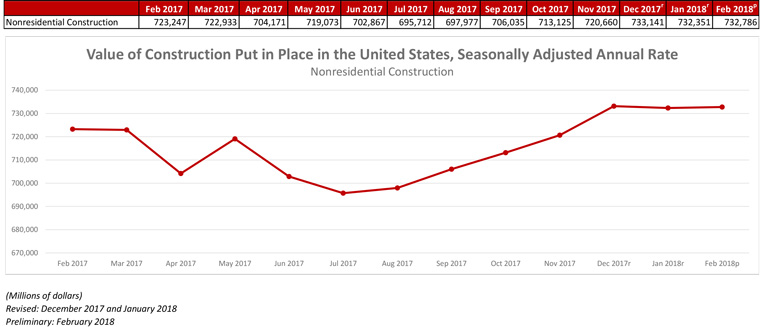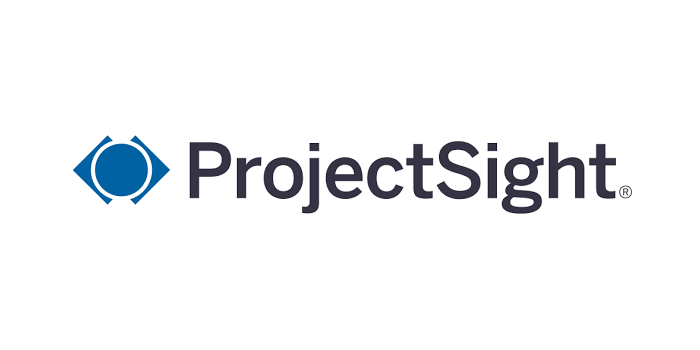
Key Takeaways
- Nonresidential construction spending increased 0.1 percent in February, totaling $732.8 billion on a seasonally adjusted basis.
- Public sector nonresidential spending fell 2.2 percent
- “Nonresidential spending growth remains tepid. Reasons for this trend include capacity constraints that continue to beleaguer contractors struggling to find enough skilled construction tradespeople, estimators and project managers."
- “Concerns regarding rising materials prices are also becoming more intense, particularly in light of the recent enactment of tariffs on steel and aluminum and growing fears of a trade war and materials shortages. Softwood lumber prices, which have been impacted by an ongoing trade dispute with Canada, were up nearly 16 percent over a recent 12-month period."
Press Release from Associated Builders and Contractors, Inc.
WASHINGTON, April 2—Nonresidential construction spending inched 0.1 percent higher in February, according to an Associated Builders and Contractors (ABC) analysis of U.S. Census Bureau data released today. Nonresidential spending, which totaled $732.8 billion on a seasonally adjusted, annualized basis, has expanded 1.3 percent since February 2017.
Private sector nonresidential construction spending increased 1.5 percent on a monthly basis and 1.1 percent on a yearly basis, while public sector nonresidential spending fell 2.2 percent for month. Public-dominated segments like conservation and development (-16.4 percent) and public safety
(-5.7 percent) experienced especially steep declines in February.
“Construction spending growth tends to reflect the degree to which new project starts exceed project conclusions,” said ABC’s Chief Economist Anirban Basu. “In a healthy economy, the expectation is that there will be considerable numbers of project starts and that, as a result, construction spending growth will be vigorous. The economy is certainly healthy judging from a wave of leading indicators, including measures of confidence, employment, new orders and gross domestic product.
“Despite that, nonresidential spending growth remains tepid. Reasons for this trend include capacity constraints that continue to beleaguer contractors struggling to find enough skilled construction tradespeople, estimators and project managers,” said Basu. “But that’s only where the issues facing construction firms and the people who use their services begin. There are also rising interest rates and borrowing costs.
“Concerns regarding rising materials prices are also becoming more intense, particularly in light of the recent enactment of tariffs on steel and aluminum and growing fears of a trade war and materials shortages. Softwood lumber prices, which have been impacted by an ongoing trade dispute with Canada, were up nearly 16 percent over a recent 12-month period. On top of all of this is sporadic growth in public construction spending as government monies continue to be siphoned away to finance underfunded pensions, Medicaid and other public priorities."
“The expectation remains that 2018 will be a solid year for construction spending growth. However, there are a growing number of headwinds, even in the context of a reasonably strong domestic economy,” said Basu. “Elected officials could help support construction spending momentum by reducing the level of uncertainty now emerging from the policymaking environment. Obviously, passage and implementation of the long-awaited federal infrastructure package also would help.”
Reporting from Reuters:
U.S. construction spending barely rises in February
WASHINGTON (Reuters) - U.S. construction spending rose less than expected in February amid a steep decline in investment in public construction projects.
The Commerce Department said on Monday construction spending edged up 0.1 percent after being unchanged in January.
Economists polled by Reuters had forecast construction spending accelerating 0.5 percent in February. Construction spending increased 3.0 percent on a year-on-year basis.
February’s marginal increase in construction spending could have implications for first-quarter gross domestic product growth estimates, which are mostly below a 2 percent annualized rate.
In February, spending on public construction projects tumbled 2.1 percent, almost reversing January’s 2.3 percent rise. February’s drop was the largest since June 2017.
Spending on federal government construction projects plunged 11.9 percent, the biggest decline since October 2004, after surging 13.4 percent in January.
State and local government construction outlays fell 1.0 percent after rising 1.3 percent in January.
Spending on private construction projects increased 0.7 percent after falling 0.7 percent in January. Outlays on private residential projects edged up 0.1 percent to the highest level since January 2007. They rose 0.1 percent in January.
Spending on nonresidential structures rebounded 1.5 percent in February after dropping 1.7 percent in the prior month.
Article from Building Design + Construction:
Construction spending in February inches up from January
Association officials urge federal, state and local officials to work quickly to put recently enacted funding increases to work to improve aging and over-burdened infrastructure, offset public-sector spending drops.
Construction spending in February inched up 0.1% from January and increased 3.0% from the February 2017 level, according to an analysis of new government data by the Associated General Contractors of America. Association officials noted that public construction dropped sharply in February and urged federal agencies to move promptly to invest recently approved funding for a variety of construction categories.
"Construction spending in February was marked by healthy gains in most private categories but a widespread and steep downturn in public construction," said Ken Simonson, the association's chief economist. "Year-over-year trends suggest overall expansion, but public investment will depend on how quickly federal agencies follow up on the spending that Congress has authorized."
Construction spending in February increased 0.1% from January to a record level of $1.273 trillion at a seasonally adjusted annual rate. The February total exceeded the year-earlier level by 3.0%. For the month, private nonresidential construction spending rose 1.5%, private residential spending edged up 0.1%, but public construction spending declined by 2.1%. On a year-over-year basis, private residential construction spending increased 5.5%, private nonresidential spending added 1.1%, and public construction spending grew by 1.6%.
"All but one of the 13 public construction categories declined for the month," Simonson pointed out. "In particular, the largest public segment—highway and street construction—decreased 0.2% from January and 5.1% compared with the year-ago level. In contrast, new single- and multifamily construction increased for the month and year-over-year, as did most private nonresidential categories."
Association officials called on federal agencies to act promptly to distribute or spend the construction funds that Congress approved last month as part of an appropriations bill that keeps the government open through September. Officials noted that programs covering highways, other transportation, water and wastewater state revolving funds, and direct federal construction received funding increases after years of spending freezes or cuts, but these authorizations in some cases will expire in less than six months.
"Federal, state and local officials should act quickly to put the newly enacted federal funding to work improving infrastructure," said Stephen E. Sandherr, the association's chief executive officer. "It would be a shame to let an entire construction season pass before putting these new dollars to work improving the nation's public works."













